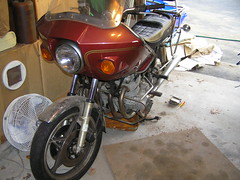This is a somewhat long post, and has been brewing in my head for a while. Grab a cup of coffee, make yourself comfortable.
I’ve been spending a lot of time lately thinking about commuting, fuel economy, vehicle types, and general transportation habits. There are changes afoot in my life that will change my driving needs, and with the ever rising price of fuel, it makes sense to take a good long look at my driving habits, and possibly make some changes.
Some Background
Between Cat and myself, we own 3 vehicles. Well, two and a half. My 2005 Saturn Relay van, Cat’s Toyota Prius, and my 25 year old Suzuki GS850 motorcycle. I can’t really consider the bike too much, as I ride it perhaps once a summer, due to it’s age and general condition, but I’d be remiss if I didn’t include it.
 Why do we have a van? Well, there’s a couple reasons. When I bought it, I was doing regular conventions, which require hauling a series of crates and hardware to the event. In addition, we own a ski boat, a camping trailer, and a utility trailer, all of which need a tow vehicle. The van does these things just fine, but these are incidental uses. Primarily, I just drive the van around – picking up Zach from school, running errands, etc. That’s not to say it isn’t useful – having that much cargo space is VERY handy, and is regularly used for hauling furniture, garbage, kids, supplies, and, yes, the occasional convention gear.
Why do we have a van? Well, there’s a couple reasons. When I bought it, I was doing regular conventions, which require hauling a series of crates and hardware to the event. In addition, we own a ski boat, a camping trailer, and a utility trailer, all of which need a tow vehicle. The van does these things just fine, but these are incidental uses. Primarily, I just drive the van around – picking up Zach from school, running errands, etc. That’s not to say it isn’t useful – having that much cargo space is VERY handy, and is regularly used for hauling furniture, garbage, kids, supplies, and, yes, the occasional convention gear.
The problem is, I’m getting increasingly worried about the cost of running the van as my primary transportation. It’s poor efficiency, plus the ever rising price of gas, requires me to take a close look at things.
Usage patterns
When evaluating this sort of thing, it’s important to take into account how you use your vehicle(s). Cat drives her Prius to work and to Zach’s school every day, around 30 miles a day. That is every day, pretty much without fail. There are additional trips to Burlington, Berlin, and other points, but the daily commute is the one that is important.
On the other hand, I have no daily commute. I work at home. When I go out to lunch, three out of four times I walk or ride my bicycle to wherever I’m going. However, I still do drive to pick up Zach at school each day, around 9 miles each way. This I have to do in the van.
Now, realistically, there’s pattern changes in the wind. The school year ends in 8 weeks or so. After that, the driving patterns change, and won’t resume, since by the time fall rolls around, our move to Mosaic will be imminent. After we move, we’ll be able to carpool with other Sudbury Valley parents in Mosaic, and we haven’t worked out what that will look like yet, but there’s a reasonable chance I won’t need to drive to SudVal every day (Around 15 miles each way).
Also, post-move, there’s a reasonable change I’ll be moving to an office nearby – within 2-3 miles, easy bikeriding range, but I’ll also spend a lot of time at Mosaic, since my job doesn’t require me to be in the office constantly.
Costs of usage
Looking at usage is only part of the story. The next step is figuring out cost of operation. I’m going to go with pure fuel costs here, not taking into account cost of vehicle, maintenance, etc. Those are really not in flux right now.
When I filled up the Prius last night, the fuel pump showed $3.20 a gallon. Per-barrel costs of crude topped $110 yesterday as well, and there’s no indication this situation will reverse – many analysts are easily calling $4/gallon prices this summer. So for the sake of comparison, lets assume a $3.50 a gallon price point for gas. I know the mileage we’re getting out of both vehicles, so here’s how it breaks down, as it compares with other vehicles I’m considering:
| Vehicle | Observed MPG | Fuel type | Fuel Price | Cost per mile | |
|---|---|---|---|---|---|
| Prius | 45 | Gas | $3.50 | 7 cents/mile | |
| Relay | 19 | Gas | $3.50 | 18 cents/mile | |
| Golf | 42 | Diesel | $4.25 | 10 cents/mile | |
| BMW R1200RT | 65 | Gas | $3.50 | 5 cents/mile | |
| VW Jetta Wagon | 30 | Gas | $3.50 | 11cents/mile |
I include the Diesel Golf in there because most folks know I had a Diesel Golf for several years, and really enjoyed it. But at that time, prices for diesel fuel were lower than gasoline. The current ridiculous diesel prices have to be considered when thinking about what vehicle makes sense.
So the question comes to mind. What makes sense for my usage patterns? I’m distinctly uncomfortable toodling around in the van to go to lunch, run to the store for something simple, go to a meeting, not to mention my regular drives down to NJ and back (500 miles total, $90 in gasoline right there).
The Cycle Option…
 I included the BMW in there because I do love motorcycles, and have been wondering about having something to have fun with. The old GS850 really isn’t going to cut it as a dependable ride – if I need to drive 500 miles to NJ and back, I want something I can really depend on. I’d have to outfit it for road travel as well (waterproof bags, etc), and putting that sort of money into the Beast just doesn’t make sense.
I included the BMW in there because I do love motorcycles, and have been wondering about having something to have fun with. The old GS850 really isn’t going to cut it as a dependable ride – if I need to drive 500 miles to NJ and back, I want something I can really depend on. I’d have to outfit it for road travel as well (waterproof bags, etc), and putting that sort of money into the Beast just doesn’t make sense.
If I’m also just commuting to the office nearby, keeping the van for “work” and driving the bike (or riding the bicycle) seems like it makes a lot of sense.
Now, natch, there’s drawbacks. I can’t take Zach with me on a motorcycle (not for a while at least), and a lot of my shuttling around is driving Z from place to place. The bike can’t haul cargo other than a couple small items, and realistically, it’s a toy for me that can be used for ‘real’ transportation, not the other way around.
Possibilities
Having said that, I do feel our lifestyle needs some sort of work vehicle for hauling, towing, and general moving stuff around. We use the van at least twice a month for something ‘heavy’ – in the summer even more so, whether it’s moving trailers, hauling big stuff, whatever. And in the coming 2-3 years, we’re going to be doing a LOT of home construction, as our houses at Mosaic are quite skeletal. We’ll be installing floors, trim, painting – not to mention all the outside work (such as installing walkways and doing general landscaping). Having a vehicle that can pick up two dozen bags of mulch quickly will be invaluable.
So, I guess this all comes down to what options do I have. The way I see it, here’s the possibilities…
- We keep things as they are, and suck it up and deal. Make decisions in a year, when we know what life at Mosaic will be like, and what our requirements are, not to mention our financial situation.
- I buy a motorcycle this summer (used). I’ll be happier because I’ll have something I enjoy driving, and I’ll save some money on fuel usage.
- We sell the van, and I get something smaller, such as VW Jetta wagon, for my regular vehicle. The top end GLS wagon gets about 30mpg (giving me a 11cents/mile operational cost), which is better than the van, but not as good as I could get. It would be a decent compromise.
- We sell the van, and I go for something super-efficient, such as a Prius or the like. This would virtually eliminate the ‘work’ capacity, and I’d be beholden to other people for doing any sort of hauling. We’re considering a ‘work’ vehicle for shared use at Mosaic, and we have friends with trucks and the like. I like this option the least, as I think we need the ‘work’ capacity fairly often, and not having it at hand would be a real problem.
- We sell the van, I get something super-efficient, and also pick up some ‘beater’ work vehicle. Some pickup truck or the like that would be used for hauling and moving and towing, but would be restricted to just that, not for general ‘run to the store’ sort of things. I like this option a lot, of course it means “another vehicle”, which is distinctly odd, but may be the most efficient way of operating.
Conclusions
I don’t have any! I really wanted to get that chart together, to sort of understand what the actual cost of owning and operating a vehicle is like given todays fuel prices. It makes me think pretty hard everytime I drive from place to place “yep, that drive to the store cost me two bucks in gas.” And while the cost is foremost on my mind, I have to make sure I remember that I’m also burning fuel with every dollar spent, and there’s other reasons to consider fuel economy other than just the cost of fuel.









